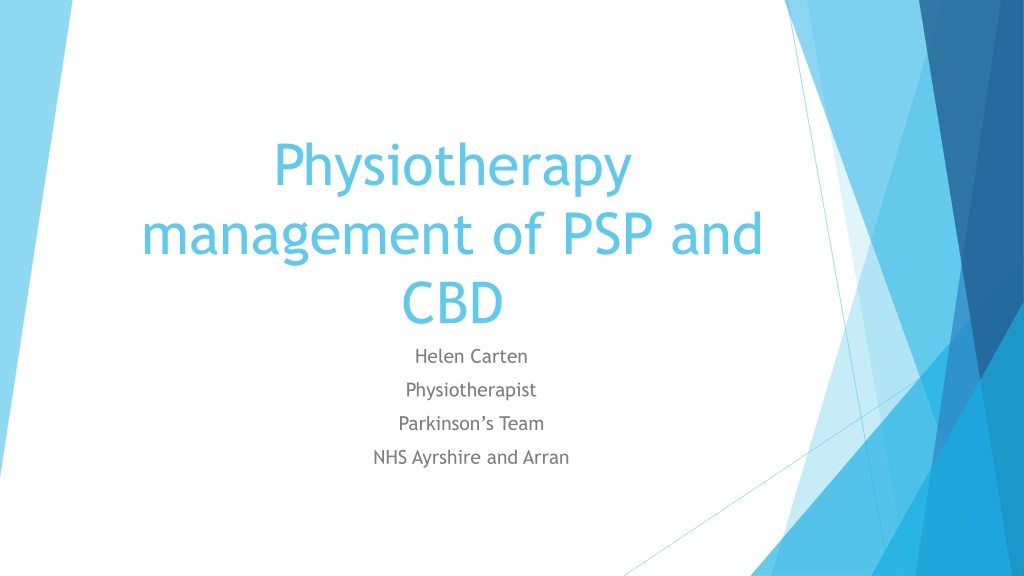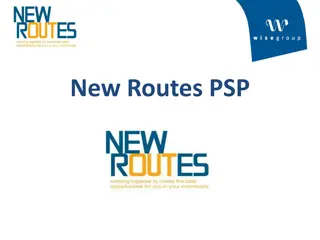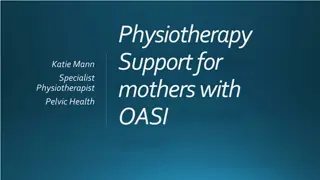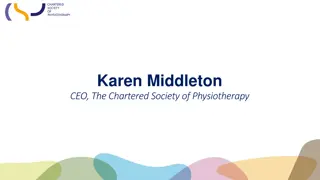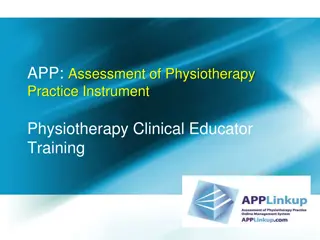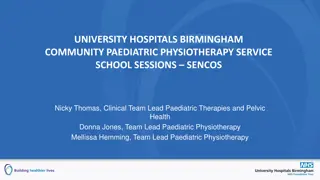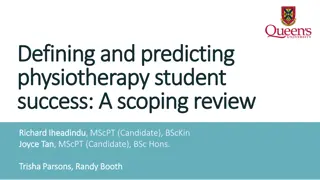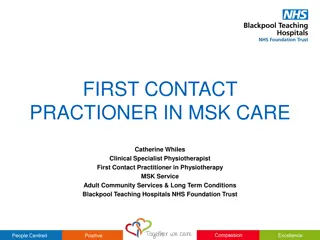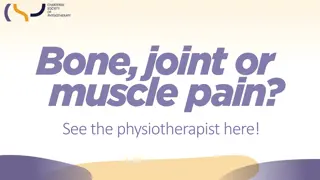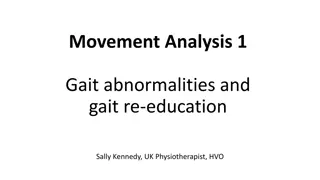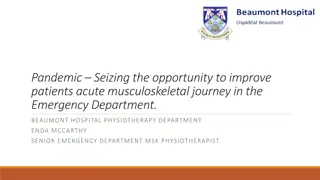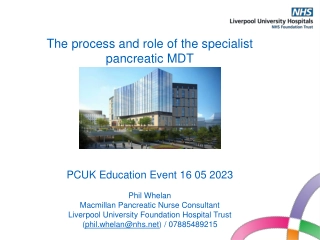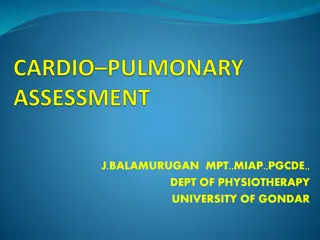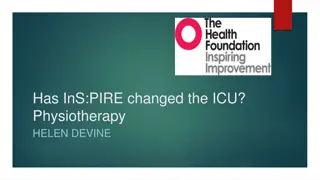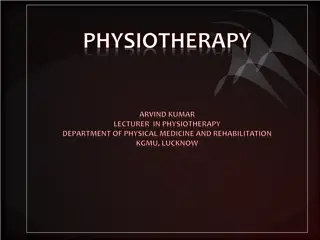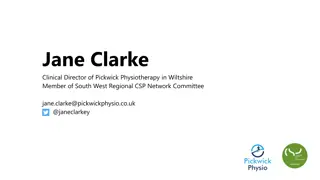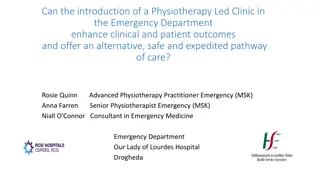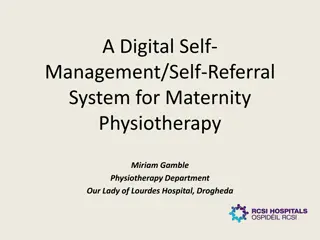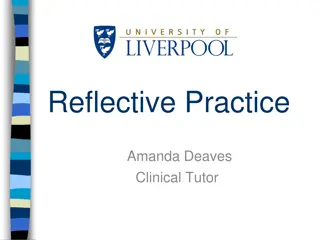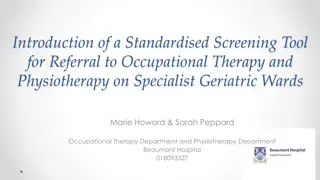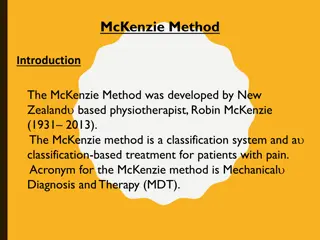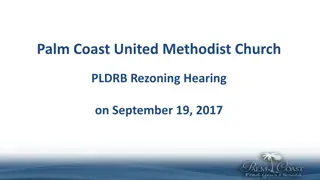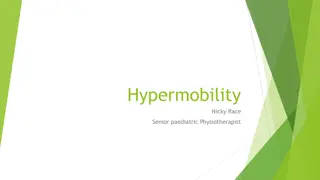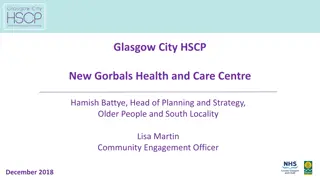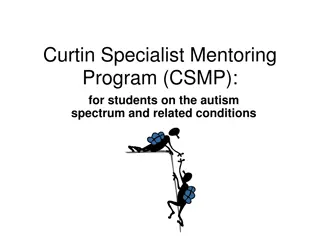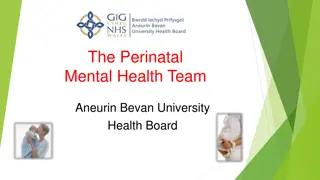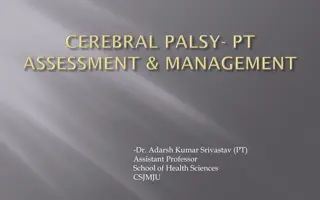Comprehensive Guide to Physiotherapy Management of PSP and CBD by Specialist Physiotherapist in Parkinson's Team
Specialist Physiotherapist, Helen Carten, from the Parkinson's Team at NHS Ayrshire and Arran, shares insights on the role of physiotherapy in managing Progressive Supranuclear Palsy (PSP) and Corticobasal Degeneration (CBD). The article covers the importance of maximizing function and quality of life, early identification of red flags, and referral pathways. Additionally, it discusses the specific challenges and distinctions between PSP and Parkinson's Disease, key areas affected by PSP, and the physiotherapy interventions involved.
Download Presentation

Please find below an Image/Link to download the presentation.
The content on the website is provided AS IS for your information and personal use only. It may not be sold, licensed, or shared on other websites without obtaining consent from the author. Download presentation by click this link. If you encounter any issues during the download, it is possible that the publisher has removed the file from their server.
E N D
Presentation Transcript
Physiotherapy management of PSP and CBD Helen Carten Physiotherapist Parkinson s Team NHS Ayrshire and Arran
Role of Physiotherapy One of the key members of the MDT involved in the care of people with PSP and CBD Our role is to maximise a person s function, ability and participation in order to have the best quality of life possible throughout their journey with PSP or CBD Raising concerns to MDT, prompt referral to Neurologist if red flags for either condition Patients should have prompt referral to Specialist Physiotherapy- access may vary Rare conditions but physiotherapists have the skills, knowledge and transferrable skills to manage patients with PSP/CBD
My role within Ayrshire and Arran In post since July 2022 as the Specialist Physiotherapist with the Parkinson s Team Parkinson s Team look after patients with the Atypical Parkinsonian conditions including PSP and CBD Part of the Atypical Clinic- prompt access to assessment, advice and ongoing follow up (clinic or home), role in aiding diagnosis with feedback to Neurologist/Consultant. Onward referrals to appropriate services Always learning!!
PSP vs PD PSP PD Falls Vision Posture Tremor Backwards- early falls Early falls rare, forward Difficulty with up/down gaze Eyes can be slow/jerky Axial rigidity, erect posture Forward leaning Rarer More common Red Flags Falls Postural Instability Slow Movement Motor recklessness Eye Problems Speech and swallow difficulty Cognitive changes Emotional lability FIGS F- Frequent falls I- Ineffective medication G- Gaze Palsy S- Speech and swallowing changes
Areas affected by PSP and presentation Basal ganglia (particularly subthalamic nucleus, substantia nigra, globus palladus Motor control and initiation, motor learning, executive functions and emotional behaviours. Also role in reward/reinforcement Brainstem Breathing, Heart rate, BP, Regulation of balance, bridge communication between cerebrum with cerebellum and spinal cord Cerebral Cortex Memory, thinking, learning, reasoning, problem solving, emotions, consciousness, sensory functions Dentate Nucleus of Cerebellum- dorsal( motor) and ventral (non-motor) domain Regulates fine control of voluntary movement, cognition, language and sensory functions
Stages and Physiotherapy intervention for PSP Early Mid Stages Later stages Can at times see improvements with intervention Strength and balance training, core and trunk, functional activities, gait, falls management, flexibility Home environment- joint working with OT Sign posting to other services Education/advice Tai chi, classes, yoga/pilates Modification of previous input for safety- motor recklessness/impulsivity Falls management Review of gait and walking aids Wheelchair referral Orthotics Functional movements Cueing Postural management Positioning Review of equipment, seating, wheelchair Focus on QOL At all stages close working with MDT, consider future planning discussions Honest discussions- clear and realistic but sensitive
Corticobasal Degeneration Common features similar to PD- Bradykinesia, Rigidity, cognition, unilateral symptoms Impairments similar to PSP- Rigidity, poor balance, motor planning/recklessness, memory, concentration, slow processing, behavioural change, speech and swallow problems, fatigue Can have similar presentation to other conditions like Alzheimer's, stroke RED FLAGS Highly asymmetrical- progressive Apraxia- clumsy/awkward hands Dystonia- Myoclonus-quick involuntary jerks Alien limb Speech Cognitive and behavioural change
Principle areas of brain affected by CBD Basal Ganglia Motor control and initiation, motor learning, executive functions and emotional behaviours. Also role in reward/reinforcement Cerebral Cortex- Memory, thinking, learning, reasoning, problem solving, emotions, consciousness, sensory functions
Physiotherapy Management of CBD Early Stages Mid stages Later stages Similar to that of PSP with other considerations Bilateral tasking Muscle strengthening Active ROM Active assisted stretching Compensation strategies Adaptive walking aids Positioning Consider referral for Botox if indicated Orthotics Passive ROM Wheelchair referral Positioning Safe moving and handling Adaptations Contracture management orthotics At all stages close working with MDT, consider future planning discussions. Honest discussions- clear and realistic but sensitive
Challenges and considerations in physiotherapy management of PSP and CBD Rare conditions but with an understanding of the condition you are able to use your skills, experience and knowledge to effectively help this group of patients Know the red flags Progressive conditions but they don t change overnight- consider other causes for sudden deterioration Walking aids don t always work Use PSPA guides and interactive tools Shifting our and patients ideas of rehabilitation/treatment and what we can do. Adapting, managing and maintaining Future planning Maximising QOL and independence Small changes can make a big difference
Case Study 1 Gentleman (70s) diagnosed with PSP. Referred to physio with balance and gait problems. Independently mobile Motor recklessness, impulsivity, postural instability, falls Initial treatment was working on high level strength and balance in PT gym Falls advice, review of walking aid, wheelchair referral Increased frequency of falls, concerns from wife regarding impulsivity and functional activities Joint visit and working with OT to explore aids , adaptations and strategies Trials of different walking aids Wheelchair referral Adaptation of exercise programme to take in to account postural instability and impulsivity/motor recklessness. Work on sit to stand to sit and transfers Developing increasing problems with swallow and respiratory issues. Mobility becoming more unsafe Joint sessions with SLT, PDNS Liaison with respiratory PT- trial of acapella. Went on to have input from them and cough assist and suction unit at home Mobile with assistance or with wheelchair Sara Stedy Referral to Social Work- this was discussed at earlier stages Support of patients wife- significant carer strain- struggled with impulsivity and behavioural changes
Case Study 2 Patient had diagnosis of possible PD, levodopa not effective, continuing have major issues with freezing and falls. ? PSP Input post fall from enhanced re-enablement services then referred to me Close liaison with patient s consultant- ongoing presentation in keeping with PSP, patient referred to Neurology Ongoing input from physio focused on safe mobility, cueing, falls prevention, modified strength, balance and functional work. Home environment contributing to concerns Referral to OT, SW, already had SLT, wheelchair referral Diagnosis of PSP confirmed by neurologist
Case study 3 Patient diagnosed with CBD, 80s. Lives alone, mobile with WZF. Supported by her daughter-in-law Progressive deterioration of function and control R side. No longer able to safely mobilise Transfers only with WZF> Sara Stedy Increased POC to x 4 daily Joint sessions with OT and PDNS Referral to Hospice Team, patient already known to PSPA Future planning- patient was clear about her future plans had been able to discuss these honestly and frankly with her daughter-in-law. Involved in supporting some of these discussions Patient decided to move to Care Home as her care needs increased and no longer able to get outdoors Followed up at care home with PDNS
Contact helen.carten@aapct.scot.nhs.co.uk
